
The Rolling Stones
By Ellie Rogers
The Rolling Stones have been around for so long that it’s tough to wrap your head around the idea that there once was a time when their music simply didn’t exist. After 60+ years of great music, it’s time to review some of their greatest albums.
It’s difficult to overstate their musical and cultural significance without a discussion of their albums. Over the course of six decades, not only have Mick, Keef and co. penned some of the greatest rock n’ roll songs of all time, but they’ve never lost the drive – or the ability – to perform live (twenty-three live Rolling Stones albums, by the way) and fill the biggest stadiums the world has to offer. It’s a remarkable feat, especially when you consider that they weren’t exactly healthy lifestyle advocates back in the day. In terms of albums sold, the Rolling Stones rank second only to the Beatles, with 240 million records sold. We highly recommend these top ten Rolling Stones albums for you to add to your own collection.
So don your lips and tongue logo t-shirt (we know everyone has one), and join us as we celebrate 10 of the finest albums The Rolling Stones ever committed to wax…
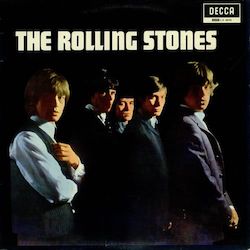
10) The Rolling Stones (1964)
Where better to begin than at the beginning – not just of The Rolling Stones as a band, but the very birth of rock n’ roll as we know it.
When The Rolling Stones released their self-titled debut album in 1964, they quickly established themselves as an antidote to everything that was trite or tame in the world of popular music. Propelled by Brian Jones and Keith Richards’ love of American blues and RnB music, the five London lads took on covers from the likes of Willie Dixon, Jimmy Reed and Chuck Berry and relaunched them as the soundtrack to modern life for young, cool rebels on both sides of the Atlantic.
In and of itself, it’s a record that’s often undervalued in The Rolling Stones’ canon – largely due to the lack of much killer material in the originals department. Of its 12 tracks, only three are self-penned, with ‘Now I’ve Got a Witness’ and ‘Little By Little’ being credited to “Nanker Phelge” – a pseudonym the band used for group compositions in the early days
This aside, The Stones’ debut is bristling with all the raw energy and wayward swagger that would come to define them. Their then producer/manager, Andrew Oldham, perhaps summed it up best when he wrote, “The Rolling Stones are more than just a group – they are a way of life” in the album’s original liner notes. Turns out, he was right on the money.
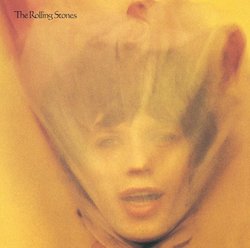
9) Goats Head Soup (1973)
Although it was met with mixed reviews upon release, time has been good to Goats Head Soup, and it’s latterly earned its rightful position as a Stones classic. It was even reissued in 2020, with the addition of three previously unreleased tracks: ‘Criss Cross’, ‘Scarlet’ & ‘All The Rage’
Any album that had to follow the spectacular Exile On Main Street was perhaps always going to be met with some disappointment, and other challenges of the time included the fact that Keith was in the clutches of heroin addiction, and it wasn’t easy to make an album recorded in three disparate locations (Jamaica, Los Angeles and London) sound cohesive.
Still, Goats Head Soup charted at number 1 on both sides of the Atlantic and included all the elements a good rock album of its time should: sex, sleaze, heartbreak and “Mr D” (aka Death/the devil).
With darkly beguiling ballads like ‘Angie’ and ‘Coming Down Again’ juxtaposed against funk-influenced bangers like ‘Doo Doo Doo Doo Doo (Heartbreaker)’ and ‘100 Years Ago’, Goats Head Soup offers a striking sonic snapshot of the bipolar highs and lows of rock n’ roll excess.
Had it been released by any other artist, it probably would have been considered a crowning achievement from day one.

8) Get Yer Ya-Ya’s Out! (1970)
Revered the world over as one of the greatest live rock n’ roll bands of all time, no list of top Rolling Stones records would be complete without at least one entry that provides the supporting evidence.
Get Yer Ya-Ya’s Out! was recorded at several concerts in New York City and Baltimore in November 1969, shortly before the release of Let It Bleed. Mick Taylor had just joined in place of Brian Jones and – despite this shake-up – the band were at the peak of their powers as an unstoppable rock n’ roll force.
Over a roaring crowd, the concert kicks off with ‘Jumpin’ Jack Flash’, and other highlights include epically jammed-up versions of ‘Midnight Rambler’ and ‘Sympathy For The Devil’. The record captures all the excitement and frenetic energy of a Stones gig in the days of innocence before the disastrous bloodbath of a concert that was to follow at Altamont Speedway just a couple of weeks later.
In a contemporary Rolling Stone Magazine review, the release was hailed as “the best rock concert ever put on record,” and after several decades of stiff competition, it’s definitely still up there.
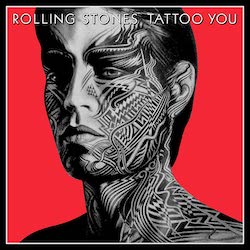
7) Tattoo You (1981)
Tattoo You is a much better album than it should have been. In 1981, Mick Jagger and Keith Richards had fallen out with each other and were failing to produce enough new material to play at their already booked summer tour, let alone to fill an entire new record.
A problem solver if ever there was one, the Stones’ long-time producer/engineer, Chris Kimsey, took it upon himself to trawl through offcuts and outtakes from the previous five records and returned with a veritable bounty of top-notch lost material.
‘Waiting On A Friend’ and ‘Tops’ came from 1972’s Goats Head Soup sessions, while the now classic ‘Start Me Up’ was a cast-off from 1978’s Some Girls. The track, which contains one of the most iconic riffs in the history of guitar music, was – believe it or not – originally intended to have a reggae feel to it.
Tattoo You became a career-revitalising record and delivered irrefutable proof that The Rolling Stones have literally forgotten better material than many bands have ever even thought of. Ouch.
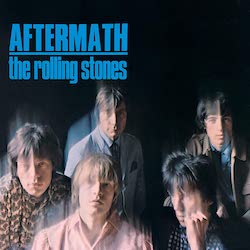
6) Aftermath (1966)
Released in 1966, Aftermath is widely considered to be the record that established The Rolling Stones as serious contenders against The Beatles in terms of their artistic output.
It was the first Stones album to consist entirely of original songs, with 11 Jagger/Richards compositions, including stand-outs like ‘Paint It Black’, ‘Under My Thumb’ and ‘Lady Jane’.
Growing beyond the standard chord progressions of the Chicago and Delta blues songs that had dominated previous albums, Aftermath boasts a more diverse palette of influences, and the whole record feels pretty “out there” thanks to Brian Jones’ visionary experiments with atypical instruments like the sitar, dulcimer, Japanese koto and marimbas.
Make no mistake, Aftermath isn’t a delicate new age flowerchild of a record, and it still packs all the sauntering delinquency that first catapulted The Rolling Stones to stardom.
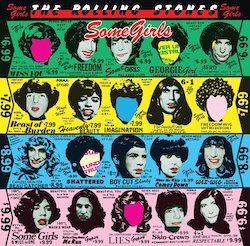
5) Some Girls (1978)
Ushering in a new era of stability with Ronnie Wood as a full-time member of the band, 1978’s Some Girls was The Rolling Stones’ 14th UK and 16th US release.
It was a decade where disco ruled the airwaves and punk rock had come along to massacre the rock stars of old and then spit on their metaphorical graves. The Beatles had long since disbanded, and Mick and Keef had reached the ripe old age of 35.
Still, Some Girls showed the somewhat unexpected ability of The Rolling Stones to keep pace with the ever-changing landscape of popular music. Disco influences are writ large upon ‘Miss You’, while ‘Shattered’ tips its hat to the New York punk scene.
The jewel of the album, however, has got to be ‘Beast Of Burden’. The smooth interplay and sharing of lead guitar roles between Keith and Ronnie is an early indicator of the greatness of their guitar playing brotherhood – one that is still going strong some four and a half decades later.
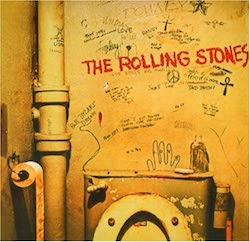
4) Beggars Banquet (1968)
Following 1967’s misfire with Their Satanic Majesties Request (a failed attempt at mirroring/parodying The Beatles’ Sgt. Pepper’s Lonely Hearts Club Band), The Rolling Stones returned to their finest form and delivered one of the greatest rock n’ roll albums ever made with Beggars Banquet in 1968.
The album, which was recorded at Olympic Studios in London and mixed at Sunset Sound in Los Angeles, will always hold a special significance because it was the last they ever completed with the original line-up of Mick Jagger, Keith Richards, Charlie Watts, Bill Wyman and Brian Jones – who drowned in his own swimming pool the following summer.
Beggars Banquet saw the Stones return to their roots, but with even more gnarly badassery than before. As the blasphemous joyride of an album opener professed, they’d picked a side and were very happy cosying up with the devil, thank you very much.
Heavy hitters like ‘Street Fighting Man’ and ‘Sympathy For The Devil’, sit comfortably alongside pastoral country blues numbers like ‘Prodigal Son’ and ‘Factory Girl’, and – to borrow a lyric from the opening track – Beggars Banquet truly is an album “of wealth and taste”.

3) Sticky Fingers (1971)
Drug-addled and ramshackle, Sticky Fingers might not be the feel-good album of the year, but it’s undoubtedly one of The Rolling Stones greatest works. It charted at number 1 in both the US and UK album charts and eventually went triple platinum stateside.
There are several things you just can’t miss about the album: most of its songs explicitly refer to the consumption of drugs, any heady optimism of the 1960s is well and truly a thing of the past, and its iconic Andy Warhol-designed artwork could literally have your eye out.
Although it’s a Richards classic, the bouncy opening riff of ‘Brown Sugar’ is at odds with the mood of the rest of the album, which is full of darkness, yearning and a bleak kind of beauty. The personal troubles, scrapes with the law and untimely deaths that filled the preceding years, it seems, made for rich creative pickings.
The musicianship on Sticky Fingers is also more sophisticated and poignant than on some of The Stones’ earlier albums, and new lead guitarist, Mick Taylor, was given plenty of room to flex his chops – particularly on the extended coda of ‘Can’t You Hear Me Knocking.’ Ry Cooder’s guest appearance playing slide guitar on the haunting ‘Sister Morphine’ is also a real highlight.
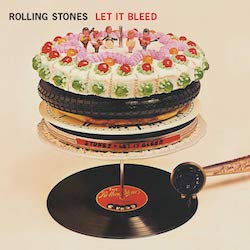
2) Let It Bleed (1969)
The dark antithesis to The Beatles’ similarly monikered Let It Be that would follow a year later, Let It Bleed captures a vortex of doom and darkness at the turn of the decade, and marks a particularly tumultuous period within the band.
Once The Stones’ propellant creative force, Brian Jones had ceased to function in his role as lead guitarist and purveyor of curious instruments, and he was unceremoniously fired midway through the recording session. Still, Richards and Jagger’s songwriting was on fire throughout and Keith, in particular, stepped up to perform some iconic lead guitar lines, proving himself to be a match for Jones in the discipline of slide guitar on tracks like ‘Let It Bleed’ and ‘You Got The Silver’.
Bookended by two of the Stones’ most celebrated tracks of all time – the apocalypto-gospel rocker ‘Gimme Shelter,’ and the bittersweet anthem ‘You Can’t Always Get What You Want’ – Let It Bleed is an all killer, no filler collection of greats that has only got better with age.
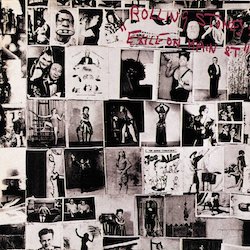
1) Exile On Main Street (1972)
Released in the spring of 1972 when the band were at the apex of their creative zenith, Exile On Main Street will forever go down in history as The Rolling Stones’ sprawling magnum opus.
Exile was very much Keith’s record: he led – in his chaotic sort of way – the creative direction of the sessions and lent his voice to the huge hit single ‘Happy’. Elsewhere, Jagger’s vocals fight for space in the mix, and the lyrics to ‘Casino Boogie’ were so fragmented at the point of recording that the song has never been performed live. Still, this collection of dark, meandering jams is sonic proof that it’s not always what you say, but how you say it that really counts.
While Exile packs its fair share of absolute classics like ‘Rocks Off’, ‘Tumbling Dice’ and ‘Sweet Virginia,’ the legends that surround the notorious recording sessions are as much a part of rock n’ roll’s sordid mythology as the songs themselves.
If walls could talk, the rented French villa that played host to the band and their motley troupe of house guests (including the likes of William S. Burroughs, Gram Parsons and John Lennon) would probably let out a hedonistic holler, stutter something slightly incoherent about “ballrooms and smelly bordellos / and dressing rooms filled with parasites”, then vomit and pass out.
Incorrigibly destructive behaviour has never had such a bitchin’ soundtrack.
The Rolling Stones website

It should have been backwards in order from 1972- 1968 with 1973 at the end. Exile, Sticky, Ya Yas, Bleed, Beggars then Goatshead Soup!!!